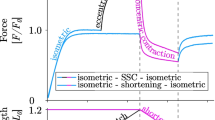Abstract
In experiments on neuromuscular junctions in the frog m. cutaneous-pectoris, changes in the intensity and asynchronicity of transmitter release during high-frequency (10 and 50 sec-1) rhythmic stimulation of the motor nerve were investigated using extracellular recording. At low extracellular Ca2+ concentrations, rhythmic stimulation resulted in a gradual enlargement of the quantum content of end-plate currents (EPC), the so-called facilitation. The latter phenomenon was accompanied by an increase in the average value and variance of synaptic delays of single-quantum EPC, a shift of the main mode of their distribution towards greater values, and an increase in the latency of the nerve ending responses. The above-described changes reduce the magnitude of facilitation in the neuromuscular synapse.
Similar content being viewed by others
REFERENCES
A. Mallart and A.R. Martin, “An analysis of facilitation of transmitter release at the neuromuscular junction in the frog,” J. Physiol., 193, C679-C694 (1967).
R. S. Zucker, “Calcium-and activity-dependent synaptic plasticity,” Sign. Mechanisms, 51, C303-C313 (1999).
M. A. Moukhamediarov, A. A. Anuchin, and A. L. Zefirov, “Mechanisms of development of short-term presynaptic plasticity in frog neuromuscular junction,” in: Motor Activity: Neurophysiological Research, Kazan (2001), pp. 103–109.
W. Van der Kloot, “Estimating the timing of quantal releases during end-plate currents at the frog neuromuscular junction,” J. Physiol., 402, C595 (1988).
M. L. Minenko and L. G. Magazanik, “Phenomena of asynchronity of evoked quantum release in frog neuromuscular junction,” Neirofiziologiya, 18, 346 (1986).
E. E. Nikolsky, E. A. Bukharaeva, D. V. Samigullin, et al., “Characteristics of the time course of evoked quantum release in different parts of frog motor nerve ending,” Ross. Fiziol. Zh., 86, 1195–1209 (2000).
A. L. Zefirov and O. Sh. Gafurov, “Analysis of pre-and postsynaptic factors of asynchronicity of transmitter release and amplitude-temporal parameters of postsynaptic response in neuromuscular junction,” Neirofiziologiya, 27, 163 (1995).
A. L. Zefirov, I. A. Khalilov, and T. Benish, “Dynamics of electric reactions of frog nerve ending in rhythmic stimulation,” in: Functions of the Motor Apparatus of Humans and Animals, Kazan (1986), pp. 16–24.
Author information
Authors and Affiliations
Corresponding author
Rights and permissions
About this article
Cite this article
Zefirov, A.L., Moukhamediarov, M.A. & Sitdikova, G.G. Changes in the Asynchronicity of Transmitter Release at the Neuromuscular Junction during Prolonged High-Frequency Stimulation. Neurophysiology 34, 264–266 (2002). https://doi.org/10.1023/A:1020708912769
Issue Date:
DOI: https://doi.org/10.1023/A:1020708912769




